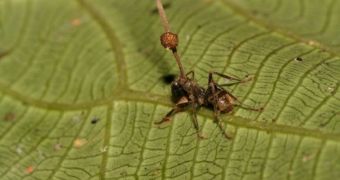Researchers say that they were finally able to gain more insight into how a fungus manages to control a certain species of ants into doing its bidding without any resistance. The finding may help understand other similar parasites as well.
A while back, the scientific community was horrified to learn about the existence of a particular type of fungus, that was capable of turning ants into zombies. Fungal cells grown into the brain of the ant and then force the insect to do whatever the fungus wants.
In addition to the mental control it exerts over the ant it infects, the organism is also capable of influencing the insect's muscles. This helps the fungus affix the ant carcass in exactly the most suitable position for its offspring to develop.
One of the most impressive things that scientists discovered in the new research is that the zombie ants appeared to clamp down on leaves precisely at noon. Furthermore, their fungal “drivers” were forcing them to into areas that researchers called zombie ant graveyards.
The team looked after about 16 infected ants, as they wandered through the forests shortly after being infected. Eventually, they settled down on a single leaf, and then bit the central vein feeding that leaf.
The Sun, temperatures and humidity are some of the factors that researchers believe could be at work in determining when the fungus sends the clamp signal to the ant's jaws, LiveScience reports.
“Synchronized arrival of zombie ants at the graveyards is a remarkable phenomenon. It adds a layer of complexity on what is already an impressive feat,” explains scientist David Hughes.
“However, although ants bite at noon they don't in fact die until sunset. Likely this strategy ensures (the fungus) has a long cool night ahead of it during which time it can literally burst out of the ant's head to begin the growth of the spore-releasing stalk.” he adds.
Hughes, who was a researcher on the new study, holds an appointment with the Pennsylvania State University. He and colleagues believe that the fungus engages in this behavior in order to ensure it secures the best possible position for itself.
In addition to taking over the ant's mind, the infecting fungus also causes muscular dystrophy in jaw muscles. “In the context of biting, it allows the mandibles, we feel, to work in one direction and one direction only,” Hughes explains.
“Normally, they open and close, but in this case they can only close,”he adds, saying that the ants can then no longer lose their grip on the leaf vein. The fungus then extracts all calcium from the ant, installing a rigor mortis-like state which freezes the ant in its final position.
“We are quite confident we could see this and similar phenomenon across a broad range of organisms, because it is such a neat evolutionary trick if you are fungus to use the muscles of an animal to transport you to another environment,” Hughes concludes.

 14 DAY TRIAL //
14 DAY TRIAL //